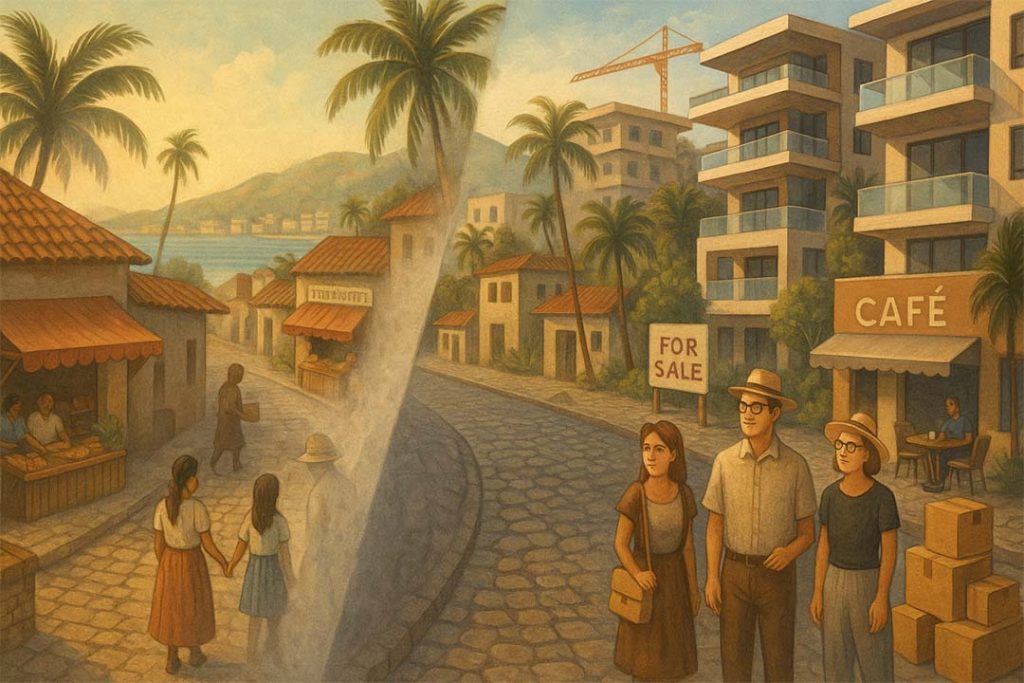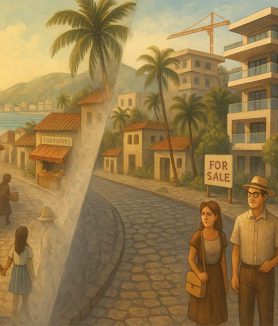Puerto Vallarta, Sayulita, Bucerías, San Pancho… they all have something in common: they are tourist destinations that have become hotspots for real estate investment. And while development brings economic growth, it can also trigger a phenomenon as silent as it is powerful: aggressive gentrification.
In this article, we analyze how tourist destinations can grow profitably without displacing their local communities or compromising their identity.
What is gentrification (and why is it important to talk about it in real estate)?
Gentrification occurs when the arrival of investment, new residents with greater purchasing power, and high-value projects raise the cost of living in an area, gradually displacing the original residents.
This manifests itself in:
- Increased rents and property prices
- Replacement of local businesses with premium brands
- Loss of cultural identity
- Social conflicts between visitors and locals
In tourist destinations, gentrification can be even more rapid, as investment and tourism dynamics constantly put pressure on the market.
Why should the real estate sector care?
Because the long-term success of a destination depends on its balance.
A market that displaces its local community not only generates social tensions but also loses authenticity, reduces its functional diversity, and jeopardizes its sustainability as a tourist and real estate destination.
Furthermore, today's buyers—especially younger ones—value cultural connection, inclusion, and the social impact of their investment decisions.
Aggressive gentrification vs. positive gentrification
Not all urban renewal processes are negative. There are important differences:
| Type of gentrification | Characteristics | Impact |
|---|---|---|
| Aggressive | Displaces residents, destroys local social networks, prioritizes speculative capital | Damage to the community, social rejection, reputational risk |
| Controlled/Inclusive | Improves infrastructure, integrates residents, promotes functional diversity | Sustainable development, local acceptance, healthy property value increase |
The challenge is to move towards the latter.
How can we avoid destructive gentrification in tourist destinations?
Here are some key strategies that developers, investors, and authorities should consider:
1. Design projects with a social purpose
Including accessible commercial spaces, mixed-use developments, and housing for local workers creates balance and real vitality.
2. Respect the scale and urban character
Architectural design should engage with the surroundings, not impose itself. Projects that integrate local aesthetics are better received and appreciate in value over the long term.
3. Genuine community participation
Involving communities from the early stages of development can prevent friction and generate proposals with a positive impact.
4. Product diversification
Not everything has to be luxury or exclusivity. Projects accessible to different types of buyers allow for a more balanced city.
5. Promote public policies that support development
Local governments have a key role in regulating land use, promoting affordable housing, and preventing speculative concentration.
Who is leading this change?
More and more developers are embracing the concept of“responsible development,”where profitability and social well-being are not mutually exclusive.
This translates into:
- Social impact certifications
- Partnerships with local foundations
- Projects that combine tourism, housing, and culture
Investing with awareness is no longer a trend: it's a market demand.
Conclusion
The future of real estate in tourist destinations depends on their ability to evolve without losing what makes them unique.
Avoiding aggressive gentrification doesn't mean halting development, but rather building a smarter, more respectful, and sustainable model.
One where everyone—residents, investors, and visitors—can thrive.
At Property Journal, we closely follow the transformation of the real estate market in tourist areas like Puerto Vallarta and Riviera Nayarit.
Subscribe to our newsletter and access more analyses like this one, delivered directly to your inbox.












